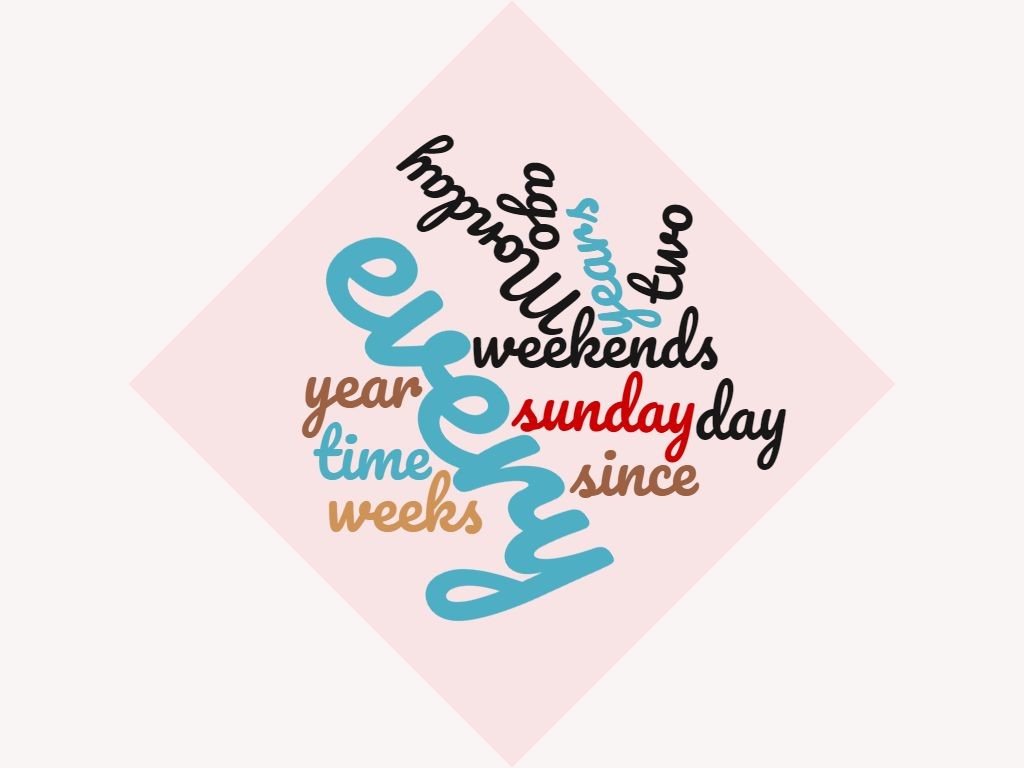These structures are used to talk about activities and habits in the past.
This lesson will get you familiarised with everyday life in the U.S in the past.
We strongly recommend that you take the time to read the instructions. Make sure you understand and comprehend the topics. You will practice the four skills: reading, writing, speaking and listening.
After you complete the exercises and tasks, you will do some quizzes and tests.

Generador de nubes de palabras online gratis. (2017). NubeDePalabras.es on 2017 [graphic]. Retrieved on 2017, March 26 from http://www.nubedepalabras.es/
At the end of this topic you will:
Identify and use adverbs of time as well as used to and past continuous forms. To compare cultural anecdotes between Mexico and the USA to express daily and in progress activities.
Can you imagine living in a culture different from yours? How similar can they be?... Regardless of the place, what did you use to do and what are you still doing?
To help you understand and use adverbs of time in their different forms look at the following information. Notice how these structures can help you describe and compare daily and past activities in progress.

Mark, D. (2010). Uss Nimitz Basketball Silhouettes Sea Ocean Water [photo]. Retrieved on 2017, March 26 from https://pixabay.com/photo-108622/
This structure is used to talk about habits in the past. It is a simple structure. This structure maintains its form for 1st and 3rd person.
Used to + infinitive verb to express affirmative sentences: |
For the negative form, we don’t include the “d” in used did not use to + verb: |
|
|
|
Interrogative forms |
|
For wh questions we don’t have many changes.
|
|

dgchpy0. (2014). Sport Exercise Escalation Bicycle Game Team [illustration]. Retrieved on 2017, March 26 from https://pixabay.com/photo-562154/
In affirmative form, we use a pronoun + was/were + a gerund (ing verb): |
Now take a look at the negative form: |
|
|
|
As you can see, you will be working with structures you already know. Look at the interrogative forms: |
|
|
|

Altmann, G. (2014). Human Group Clock Time Silhouette Background [illustration]. Retrieved on 2017, March 26 from https://pixabay.com/photo-439149/
|
An adverb of time tells us not only when but also how long and how often an action happened. They are commonly used in English and they have a special position depending on the emphasis of the action occurred.
Last year Can you recognize them in the past examples? |
Great! Now that you have read about and can distinguish these elements, it is time to put them to use. Remember that the main topic is daily activities in the past, including adverbs of time. They will help you better understand, and compare cultural anecdotes between Mexico and the USA.
Remember, you can return to this section as many times as necessary.

Conway, C. (2016). Students [gif]. Retrieved on 2017, March 26 from http://gph.is/2d8Usll
Activity 1
Many people have visited the USA and have noticed that there is a big difference as far as habits and routines between the USA and their home country.
In this activity you will read a text where a person talks about the time, he spent in Phoenix, Arizona. He will mention how often and how long they lasted. When reading the text, notice the expressions that highlight the time and frequency of the events.
I would suggest scanning the text to see if there are any unknown words. If so, you can look them up in one of the following dictionaries.
1. Merriam Webster
2. Cambridge Dictionary
After reading the text, try to distinguish between habits and actions that were in progress.

Mauricio (2017)
How many uses of the adverbs of time could you distinguish?
Notice that the text structure lets us recognise every day past actions or actions in progress at a certain point in the past.
Activity 2
Now you will hear audio based on the reading. You will test your listening abilities, and identify the use of the adverbs of time to talk about past activities.

TerrenceGraduatePortfolio. (2017).Teacher_Cartoon2 [gif]. Retrieved on 2017, March 26 from http://gph.is/2cRm9yE
Listen to the audio and substitute the expressions in the text for the adverb of time. Click to replace each expression.
Now that you have finished I encourage you to continue practising what you have learned. Getting a pen pal would be a good idea, as well as keeping a journal of the things you used to do. Keep up the good work and finish the rest of the unit. I know you can do it!
Activity 3

OpenClipart-Vectors. (2017). Communication Document Letter Mail Mailer Message[image]. Retrieved on 2017, March 29 from /
Now it is your turn to put into practice what you already know. Write an 80-100 word text where you describe the activities you used to do in high school as well as the ones that were in progress. Do not forget to mention when and how long they took place using the adverbs of time. Follow this example:
• In high school, I used to take two buses to get home.
• I used to do all my homework on the very same day it was assigned.
• In high school, I was always fooling around with my friends.
• When I was in high school, I used to exercise more often.
Please check out the rubrics so you can write your paper correctly. Notice the use of the grammar of this unit.
Great! You are almost finished. Keep working hard like you have been doing.
Remember that we use these expressions to talk about past habits. We always have memories we like to share and sharing them properly is still good.
Activity 4
Now, let’s see how well you can use this in a speaking activity.
Imagine that you have received a scholarship at the Proyecta 100 mil consisting of spending a month the U.S. However, you are not sure where to go to. The counsellor is interviewing you. You are talking about the activities you used to have in your hometown.
Make sure to mention all the relevant aspects, highlight your past habits and activities in progress. Do not forget to include some adverb phrases.
Create your script based on the interviewer's questions. Use each microphone icon so you can record yourself on a web page. There will be a final file which you can upload and listen to it later.
Choose one of the characters you want to interact with. Remember that you are interacting with the audio, so don't forget to pause. You can also download the interview script.
Please check out the rubrics so you can know what you will be graded on. Make sure to cover the task altogether.
Awesome! Now that you have finished, I encourage you to complete the self-assessment.
Remember that the structure used to is used to talk about past daily routines or habits.
We use past continuous to mention any activities in progress in the past.
Finally, adverb phrases help us express how often and how long we did those activities.
Great job!
As previously explored, these forms will not only help you understand and use the tense correctly but also talk about past events.
• Ego4u.com. (2017). English Grammar Online - free exercises, explanations, vocabulary, dictionary and teaching materials. Retrieved on 2017, March 21 from http://ego4u.com
• British Council. (2017). Learn English | British Council. Retrieved on 2017, March 21 from http://learnenglish.britishcouncil.org/es